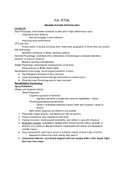Class notes
FULL YEAR: Class notes: Kinesiology 1070A - Psychology of Human Movement Science (Kinesiol1070A)
- Institution
- University Of Western Ontario (UWO )
This document is for notes for the entire course of Kinesiology 1080B - Introduction to Psychomotor Behaviour
[Show more]



